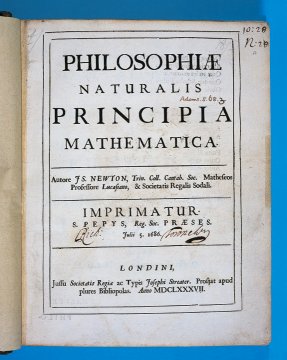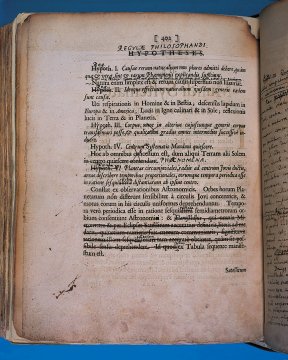|

Title page of the Principia no. 80
The publication of the Principia in 1687 secured Newton's intellectual reputation. It was the culmination of almost three years of frantic effort by Newton and by Edmond Halley, who saw the book through the press in London. Although many of the ideas in the Principia can be traced back as far as the 1660s, the form in which they were set out and the conclusions that were drawn from them were very much the product of the years 1684-7.
In August 1684, Halley told Newton about a conversation that he had had at the Royal Society concerning planetary motion. Anxious that others might take the credit for discoveries that he felt were already his, Newton went to work to prove his theories of celestial dynamics.
Drafts were composed and rushed to Halley in London to indicate Newton's priority. Copies of some of them were later deposited in the University Library as if they had been his Lucasian lectures. Yet, despite the haste, these manuscripts show that Newton had indeed now solved the principal problems of celestial mechanics. The final text of the Principia set out his mature thoughts about the operation (although not the cause) of gravity. Structured to follow the rules of scientific reasoning that Newton developed, the Principia nevertheless baffled many readers, who complained that not even its author could possibly understand it.

On 5 July 1687, Halley wrote to Newton: 'I have at length brought your Book to an end, and hope it will please you. the last errata came just in time to be inserted.' Despite the acclaim that greeted his achievements, however, Newton still felt that there was more to be done. A particular problem remained the explanation of universal gravitation. Newton's treatment of gravity had been one of the revolutionary aspects of his work. By showing that its effects could account in detail for the movements of the heavens, Newton had been able to give universal force to the laws of motion that he propounded.
Yet, in the eyes of many of his most distinguished contemporaries, his achievement was qualified by the failure to provide a properly philosophical account of gravity. Newton could describe the effects of gravitation but he could not explain them adequately. Newton's friend, Nicolas Fatio de Duillier, felt that he had the answer and, for a time in the early 1690s, it seemed possible that he might produce a new edition of the Principia. Others of Newton's growing band of young disciples, particularly David Gregory, also discussed his plans to augment the work.
Newton himself returned to his chemical experiments (see catalogue number 14) and to the optical papers of the mid-1670s (see catalogue numbers 26 and 28). With Fatio's prompting, he reconsidered the possibility that some sort of subtle matter or aether might be responsible for the effects of gravity. Newton's historical and theological reading encouraged him to search for more wide-ranging philosophical explanations. He confided many of these to Gregory, in particular ideas that the divine will itself might animate the actions of gravity.
Newton was by now familiar with a wide range of classical and patristic sources, with the ideas of Philo of Alexandria, and with the syncretising interpretations that had been placed on them by early modern authors, including the Cambridge Platonists and, perhaps, Justus Lipsius. He came to believe that these sources provided evidence to support his interpretation of gravity. They allowed him to construct a history of religion in which his own metaphysical speculations became identical with the true doctrinal foundations of pristine belief.
The marriage of theology, ancient history, and philosophy that Newton attempted to broker in the 1690s (see catalogue number 56) in fact looked back to work that he had suppressed in the mid-1680s. This included the drafts that he had initially composed for what became Books II and III of the Principia, as well as the related 'Theologiae gentilis origines philosophicae' (see catalogue number 15). In the manuscript of 'De motu corporum liber secundus' (see catalogue number 7), Newton gave an account of the fluid heavens through which both planets and comets were propelled by a force that obeyed the inverse square law.
This began with a discussion of the philosophy of the ancient atomists, the religion of Numa Pompilius, and the astronomy of the Egyptians and Babylonians. These were Newton's predecessors in the restoration of the true understanding of nature, who had had privileged access to the teachings of a pristine religion before its corruption by vain men. Increasingly, the writings of Newton and his closest disciples would focus on the restoration of religion that had to follow the rediscovery of ancient philosophy. At the same time, Newton began to collect further evidence that ancient understandings of gravity and of celestial motion were similar to his.
Most of Newton's difficulties continued to relate to the final parts of Book II and to Book III of the Principia. At the start of Book III, he had defined a number of hypotheses that would govern his approach to natural phenomena. He began to modify these in the early 1690s, gradually developing them into a set of rules for the practice of natural philosophy. These rules were supposed to underpin the interpretation of a group of phenomena that Newton again introduced in changes that he made to the text of the first edition. Newton entered these corrections onto p. 402 of an interleaved copy of the Principia (see figure 25) and onto the blank leaf facing that page.
On 21 July 1706, David Gregory wrote:
'Sir Isaac Newton shewed me a copy of his Princ. Math. Phil. Nat.
interleaved, and corrected for the Press. It is intirely finished as farr as Sect. vii. Lib. II. pag. 317. He takes this same Sect. vii. to be the hardest part of the book… In the beginning of Lib. III. he leaves out Hyp. iii, and puts another in its place… These three he now calls Regulae Philosophandi. Hyp. v. &c he calls by the title of Phaenomena. Hyp. iv is the only one that he leaves that name to; & it comes after the Phaenomena.'
Preparations for the printing of a second edition of the Principia began in 1708. The changes that Gregory had described were eventually incorporated in that edition. A few of Newton's more adventurous ideas of the 1690s also persisted in the form of a new 'General Scholium' at the end of Book III (see catalogue number 62). A fourth 'Regula Philosophandi' was added to the third edition of the Principia in 1726. Taken together, such alterations helped to establish the myth of Newton as a philosopher who did not 'feign hypotheses'. Yet, paradoxically, that was exactly how he had originally started to explain the system of the world.

back to the top
|

